Interact Rover
People and News
Interact Rover Plus Astronaut Complete Mount Etna Challenge
July 2022: In a complex role-played version of a mission to the Moon, controllers at ESOC combined with a team of geological scientists and ESA astronaut Thomas Reiter to oversee a rover’s collection of rock samples. Acting as if he were in lunar orbit, the astronaut was in fact based in a hotel room in Catania, Sicily, with the rover 23 km away and 2 600 m uphill on the volcanic flanks of Mount Etna. As Thomas commanded the rover to pick up rocks his hand experienced just what the robot’s gripper felt – an added dimension in remote control. 1)
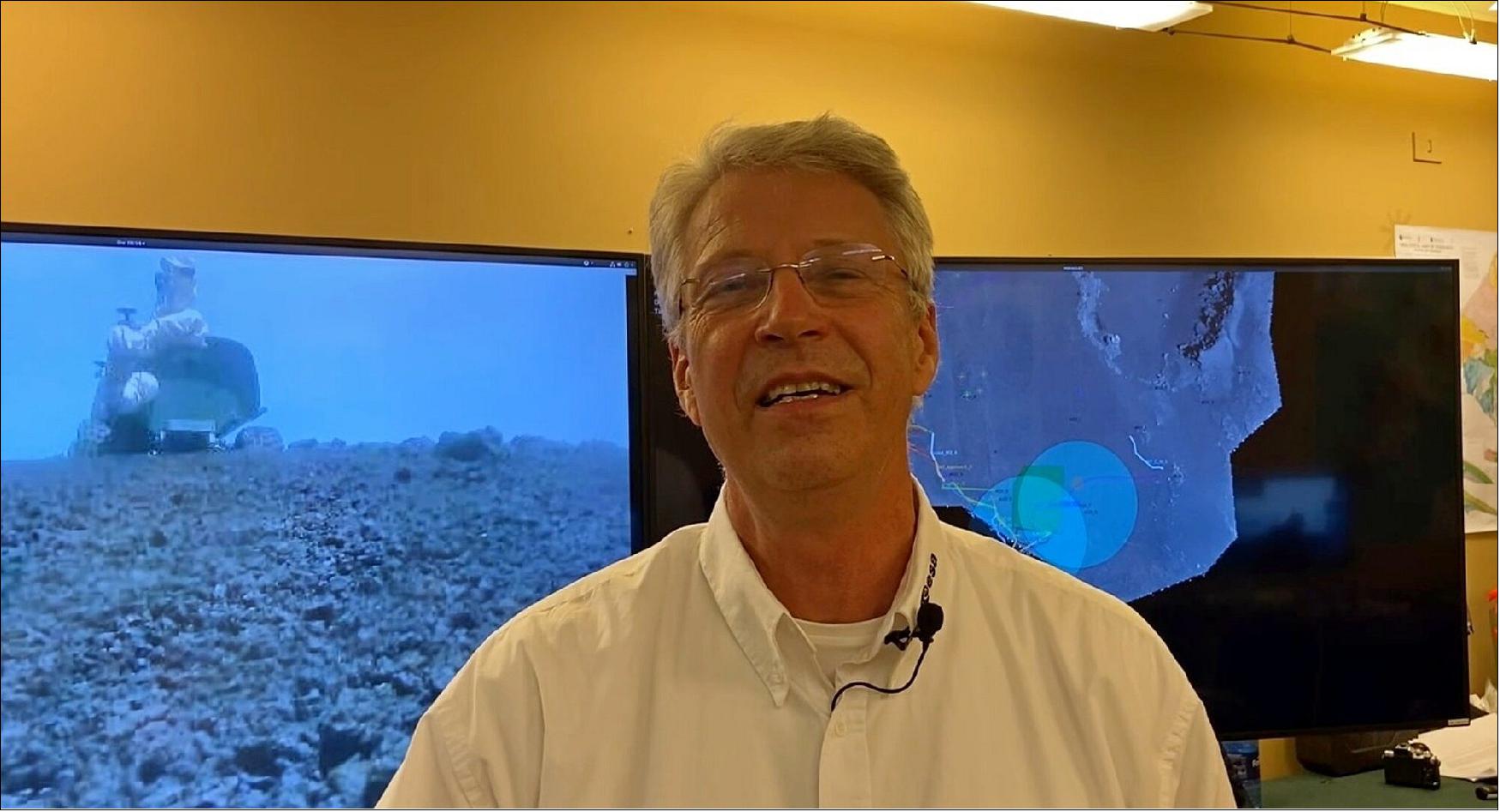
This concluding part of ESA's ‘Analog-1’ project took place as part of a larger multi-agency, multi-rover campaign, organised by the DLR German Aerospace Center. The Autonomous Robotic Networks to Help Modern Societies, ARCHES, project probed the ability of autonomous robots to collaborate and share data on a networked basis.
ESA’s four-wheeled, two-armed Interact rover was built by the Agency's Human Robot Interaction Lab and modified for the rugged slopes of the volcano. This robot formed part of a team consisting of two DLR rovers – Lightweight Rover Units 1 and 2 – along with a fixed ‘lunar’ lander supplying WiFi and power to the rovers, plus a drone for surface mapping. The Karlsruhe Institute of Technology (KIT) contributed the centipede-like Scout crawler, optimised for tough terrain, which could also serve as a relay between Interact and the lander, boosting its effective area of operations.
The rover’s delivery of rocks to the lander marked the conclusion of a four-day simulated mission in which a rover landed on the Moon to collect samples, guided by a rover operations centre and science backroom on Earth, and an astronaut aboard the lunar Gateway station. The rover operations were coordinated from ESOC in Germany, while the astronaut and scientists were kept in separate rooms in a nearby hotel.
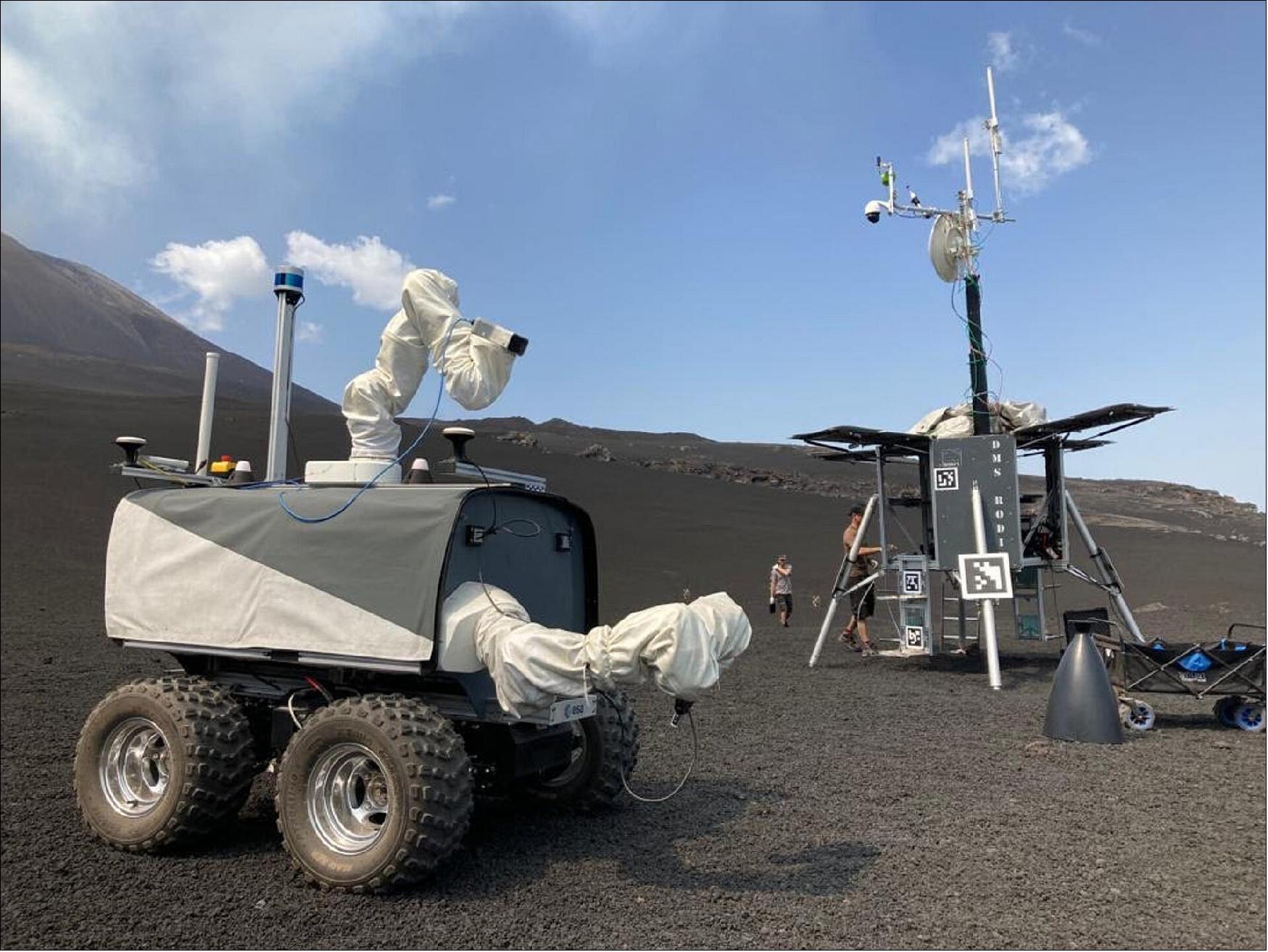
"A simulated mission like this is essentially a role-play in which it is very important that the in-scenario players experience complete immersion." said Analog-1 project manager Kjetil Wormnes.
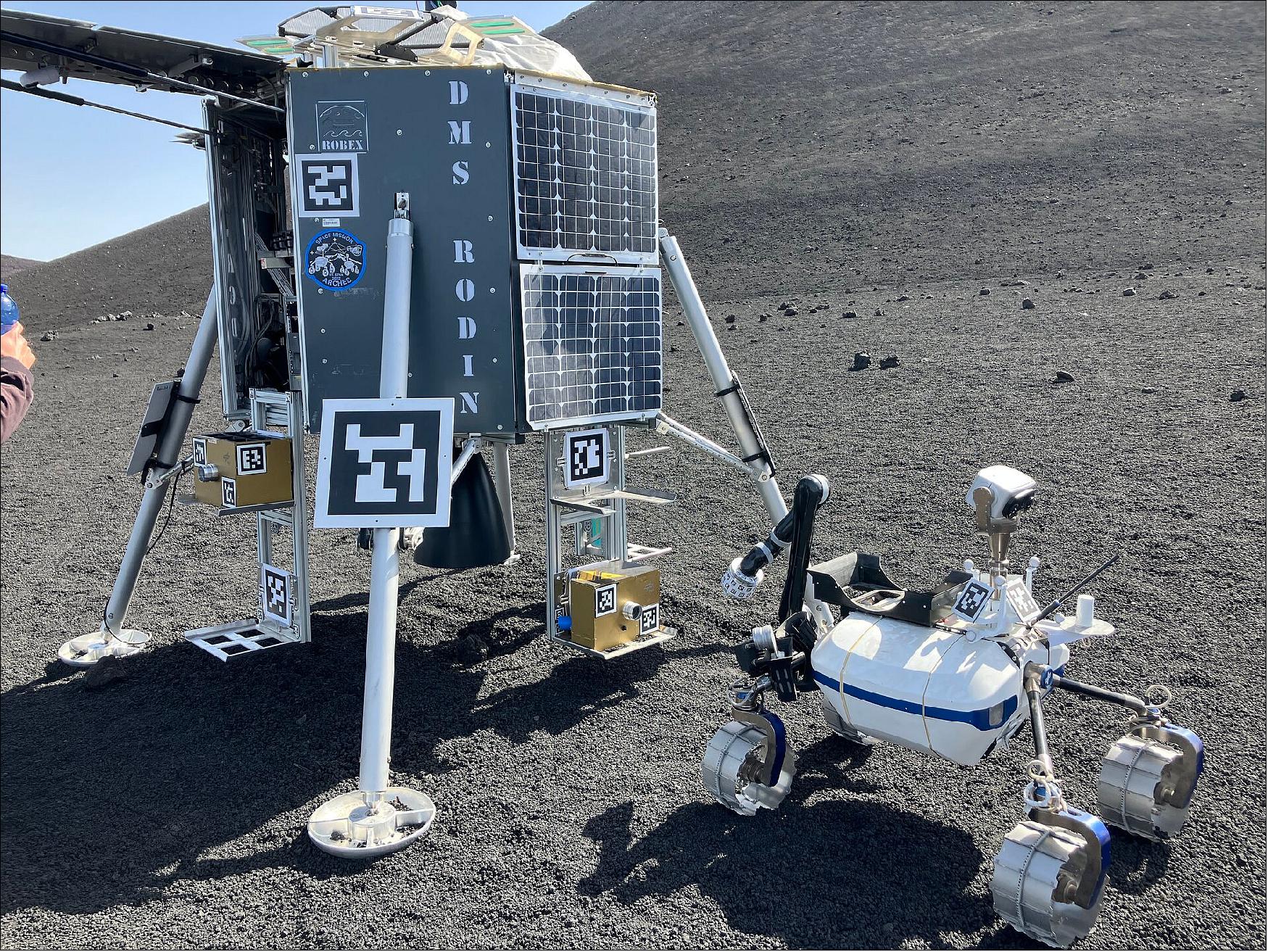
"In this case, that meant the rover operators at ESOC, as well as the scientists in the science backroom, and of course the astronaut on board our analogue lunar Gateway all needed to feel they were on the Moon. Mount Etna was chosen as the analog site for its excellent lunar-like geology, allowing suitably deep immersion, while the astronaut and the scientists were kept apart in a hotel in nearby Catania.”
For maximum realism a second of signal delay was added to the rover control system, equivalent to the time it would take commands to travel between the Gateway station and the lunar surface. The force feedback control method has been designed to operate with such delays.
Kjetil added: "It was a challenging setup, but the systems worked extremely well, and we learned a lot about operating a rover on the Moon that can help us when we do this for real in the future. We’re very happy because it took a lot of work to reach this point, and the testing here at Etna was repeatedly delayed due to COVID-19.”
Thomas Reiter commented: “We’ve learned a lot about collaboration between ground control on Earth and the crew aboard a space station orbiting the Moon, both operating a rover on the surface – this “shared” operation can be extremely efficient –much more efficient than if either side does it alone.”
Thomas Krueger, heading ESA’s Human Robot Interaction Lab, said: “Today’s success is exciting because it means we can now consider this force feedback control method proven, and ready to be brought to the table with our international partners in the planning of future lunar exploration.
“It has been a long road to get to this point: our team began work on the concept more than a decade ago, progressively building in more complexity. We started with a simple joystick that could be remote controlled by an astronaut in orbit studying the perception of force feedback in weightlessness, then our lab developed the Interact rover expressly to be operated from space. Next we moved to the first full-scale Analog-1 test campaign, steered by Luca Parmitano from the International Space Station across a mock moonscape in a Dutch hangar.”
The only test left undone was to prove that the system could cope with the inherent unpredictability of an outdoor, natural environment – now achieved with this latest Mount Etna campaign. Thomas Reiter contended with a steep slopes and the rover’s wheels getting trapped in sand, but still managed to retrieve the samples and return them to the waiting lander.
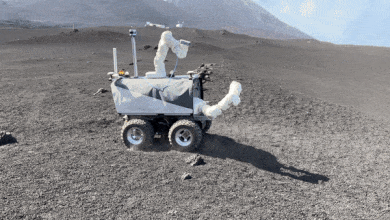
Thomas Krueger added: “There is quite a lot of sophistication embedded into the rover. What we soon found was that continuous remote oversight was very demanding on the astronaut operator, so we added in features to take some of the pressure off – equivalent to the assisted driving offered by modern cars. So for example the operator can point to a location and let the rover decide for itself how to get there safely. And its neural net has been programmed to recognise scientifically valuable rocks for itself.
“That way the operator is left free to focus their attention on the kinds of priority tasks that humans are best equipped to handle. This turned out to be tough terrain for wheeled vehicles, so it was an enormous relief to see how well it turned out.”
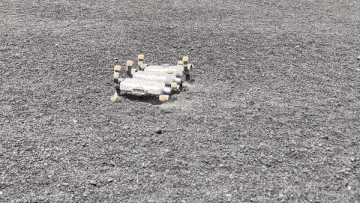
The final day of testing saw the rovers working together to place an array of ‘LOFAR’ (Low Frequency Array) antennas in optimal locations across the ‘lunar surface’ in order to perform radio astronomy.
In fact these antennas were working models, and astronomers spent a night on the mountain to perform a radio sky survey, succeeding in picking up a radio burst from Jupiter, caused the passage of its volcanic moon Io through its magnetic field.
“I’m confident that we will be perfectly prepared in the second half of this decade to do exactly this kind of shared operation between ground and the space station, controlling a rover on the surface of the Moon,” concluded Thomas Reiter.
“By the way, the moment will come when even European astronauts will leave their footprints on the surface of the Moon! And even in such a scenario the shared operation of robotic systems and the crew on the surface will be extremely efficient.”

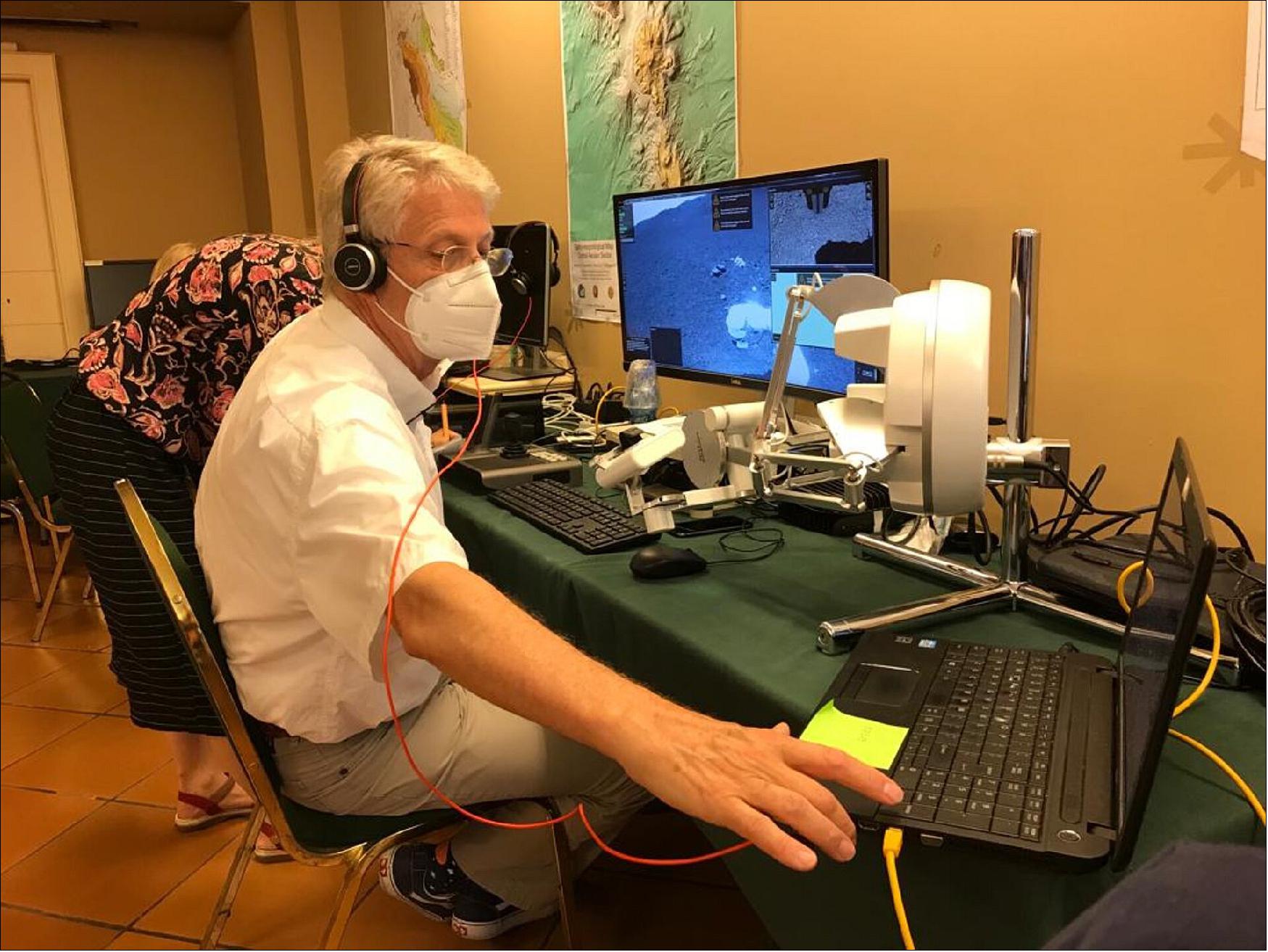
References
1) ”Rover plus astronaut complete Mount Etna challenge,” ESA Enabling & Support, 6 July 2022, URL: https://www.esa.int/Enabling_Support/Space_Engineering_Technology/Rover_plus_astronaut_complete_Mount_Etna_challenge
2) ”Thomas Reiter at the controls,” ESA-Agency, 6 July 2022, URL: https://www.esa.int/Enabling_Support/Space_Engineering_Technology/Rover_plus_astronaut_complete_Mount_Etna_challenge
The information compiled and edited in this article was provided by Herbert J. Kramer from his documentation of: ”Observation of the Earth and Its Environment: Survey of Missions and Sensors” (Springer Verlag) as well as many other sources after the publication of the 4th edition in 2002. - Comments and corrections to this article are always welcome for further updates (eoportal@symbios.space).